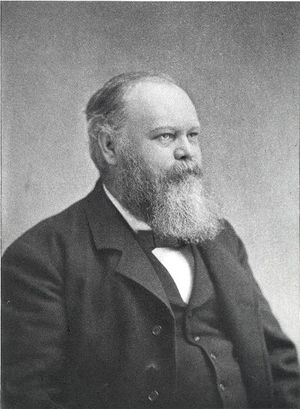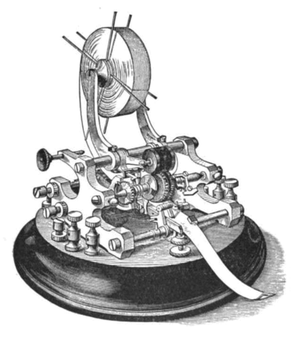Franklin Pope: Difference between revisions
No edit summary |
No edit summary |
||
| Line 1: | Line 1: | ||
== Franklin Pope: Biography == | == Franklin Pope: Biography == | ||
[[Image:Franklin L Pope 2194.jpg|thumb|left]]Born: 1840 | <p>[[Image:Franklin L Pope 2194.jpg|thumb|left]]Born: 1840 </p> | ||
Died: 1895 | <p>Died: 1895 </p> | ||
Pope was [[Presidents of the American Institute of Electrical Engineers (AIEE)|president of the AIEE]] from 1886 to 1887. | <p>Pope was [[Presidents of the American Institute of Electrical Engineers (AIEE)|president of the AIEE]] from 1886 to 1887. </p> | ||
Pope, Franklin Leonard, electrician, was born in Great Barrington, Mass., Dec. 2, 1840, near the house in which he met his death by the mysterious agent that made him famous. It was from 1876 known as the "Old Pope House," and was erected in 1766. His education was received in his native town, and in 1857 he became a [[Telegraph|telegraph]] operator. He was one of the earliest practicing electrical engineers in the country. In 1862 he was made assistant engineer of the American Telegraph Co., whose lines extended from New York to Boston, but were then disconnected at Washington, owing to the existing hostilities between the North and South. In 1863, during the draft riots, he repaired with his own hands the demolished telegraph lines between New York and Boston. In 1864 he was engineer for the Russo-American Telegraph Co., and while in their service surveyed the route for the proposed Collins overland telegraph between British Columbia and Alaska, which was abandoned after being partially built; the successful laying of the Atlantic cable making useless the project of constructing a telegraph line by way of Bering Straits. Subsequently Mr. Pope was engaged as an electrical engineer and expert in New York city, and his mastery of the rapidly developing science gave him a world-wide fame. He entered into partnership with [[Thomas Alva Edison|Thomas A. Edison]], under the firm-name of Pope & Edison, and in 1870 they invented the one-wire printing telegraph, now used in an improved form in large cities for exchange quotations, and known as the stock "ticker". In 1872 Mr. Pope invented the rail circuit for automatic control of the electric-block signal system, now in general use on the principal railroads of the United states, and many other improvements in telegraphy. He was one of the earliest patent solicitors making electrical inventions a specialty, and for many years filled the office of patent attorney for the Western Union Telegraph Co., and was retained as an expert in many of the most important patent suits brought before the U.S. courts. Mr. Pope contributed largely to both technical and popular periodicals on electrical subjects, .and was author of "Modern Practice of the Electric Telegraph" (1871, rewritten in 1891), and "Life and Work of [[Joseph Henry|Joseph Henry]]" (1879). From 1884 he was editor of the "Electrical Engineer." In 1886 he succeeded Dr. [[Norvin Green|Norvin Green]] as [[Presidents of the American Institute of Electrical Engineers (AIEE)|president of the American Institute of Electrical Engineers]], of which he was a charter member. | <p>Pope, Franklin Leonard, electrician, was born in Great Barrington, Mass., Dec. 2, 1840, near the house in which he met his death by the mysterious agent that made him famous. It was from 1876 known as the "Old Pope House," and was erected in 1766. His education was received in his native town, and in 1857 he became a [[Telegraph|telegraph]] operator. He was one of the earliest practicing electrical engineers in the country. In 1862 he was made assistant engineer of the American Telegraph Co., whose lines extended from New York to Boston, but were then disconnected at Washington, owing to the existing hostilities between the North and South. In 1863, during the draft riots, he repaired with his own hands the demolished telegraph lines between New York and Boston. In 1864 he was engineer for the Russo-American Telegraph Co., and while in their service surveyed the route for the proposed Collins overland telegraph between British Columbia and Alaska, which was abandoned after being partially built; the successful laying of the Atlantic cable making useless the project of constructing a telegraph line by way of Bering Straits. Subsequently Mr. Pope was engaged as an electrical engineer and expert in New York city, and his mastery of the rapidly developing science gave him a world-wide fame. He entered into partnership with [[Thomas Alva Edison|Thomas A. Edison]], under the firm-name of Pope & Edison, and in 1870 they invented the one-wire printing telegraph, now used in an improved form in large cities for exchange quotations, and known as the stock "ticker". [[Image:Stock ticker.png|thumb|right|Stock Ticker]]In 1872 Mr. Pope invented the rail circuit for automatic control of the electric-block signal system, now in general use on the principal railroads of the United states, and many other improvements in telegraphy. He was one of the earliest patent solicitors making electrical inventions a specialty, and for many years filled the office of patent attorney for the Western Union Telegraph Co., and was retained as an expert in many of the most important patent suits brought before the U.S. courts. Mr. Pope contributed largely to both technical and popular periodicals on electrical subjects, .and was author of "Modern Practice of the Electric Telegraph" (1871, rewritten in 1891), and "Life and Work of [[Joseph Henry|Joseph Henry]]" (1879). From 1884 he was editor of the "Electrical Engineer." In 1886 he succeeded Dr. [[Norvin Green|Norvin Green]] as [[Presidents of the American Institute of Electrical Engineers (AIEE)|president of the American Institute of Electrical Engineers]], of which he was a charter member. </p> | ||
One of his latest undertakings was the construction of the Great Barrington electrical plant, which embodied many interesting features, that were described in a paper read at the meeting of the Institute at Niagara Falls in June, 1895. The principal buildings of the plant are at Housatonic, five miles north of Great Barrington. In order to watch the operations of the plant, Mr. Pope had the primary wires brought to a converter placed in his cellar, instead of to a pole outside, as is the usual practice. On the evening of Oct. l3, 1895, when the power was turned on, his home lights did not work satisfactorily, and he went into the cellar to examine the wires. He was instantly killed by 3,000 volts passing through his body. Mr. Pope was married, in 1872, to Amelia Dickinson of Amherst, Mass., by whom he had three children, two daughters and a son. | <p>One of his latest undertakings was the construction of the Great Barrington electrical plant, which embodied many interesting features, that were described in a paper read at the meeting of the Institute at Niagara Falls in June, 1895. The principal buildings of the plant are at Housatonic, five miles north of Great Barrington. In order to watch the operations of the plant, Mr. Pope had the primary wires brought to a converter placed in his cellar, instead of to a pole outside, as is the usual practice. On the evening of Oct. l3, 1895, when the power was turned on, his home lights did not work satisfactorily, and he went into the cellar to examine the wires. He was instantly killed by 3,000 volts passing through his body. Mr. Pope was married, in 1872, to Amelia Dickinson of Amherst, Mass., by whom he had three children, two daughters and a son. </p> | ||
(Copied from The National Cyclopaedia of American Biography, Volume VII, 1892) | <p>(Copied from The National Cyclopaedia of American Biography, Volume VII, 1892) </p> | ||
See also: [[Papers of Franklin L. Pope|Papers of Franklin L. Pope]] | <p>See also: [[Papers of Franklin L. Pope|Papers of Franklin L. Pope]] </p> | ||
[[Category:People_and_organizations]] [[Category:Engineers]] | <p></p> | ||
<p></p> | |||
<p>[[Category:People_and_organizations]] [[Category:Engineers]]</p> | |||
Revision as of 18:29, 20 July 2010
Franklin Pope: Biography
Born: 1840
Died: 1895
Pope was president of the AIEE from 1886 to 1887.
Pope, Franklin Leonard, electrician, was born in Great Barrington, Mass., Dec. 2, 1840, near the house in which he met his death by the mysterious agent that made him famous. It was from 1876 known as the "Old Pope House," and was erected in 1766. His education was received in his native town, and in 1857 he became a telegraph operator. He was one of the earliest practicing electrical engineers in the country. In 1862 he was made assistant engineer of the American Telegraph Co., whose lines extended from New York to Boston, but were then disconnected at Washington, owing to the existing hostilities between the North and South. In 1863, during the draft riots, he repaired with his own hands the demolished telegraph lines between New York and Boston. In 1864 he was engineer for the Russo-American Telegraph Co., and while in their service surveyed the route for the proposed Collins overland telegraph between British Columbia and Alaska, which was abandoned after being partially built; the successful laying of the Atlantic cable making useless the project of constructing a telegraph line by way of Bering Straits. Subsequently Mr. Pope was engaged as an electrical engineer and expert in New York city, and his mastery of the rapidly developing science gave him a world-wide fame. He entered into partnership with Thomas A. Edison, under the firm-name of Pope & Edison, and in 1870 they invented the one-wire printing telegraph, now used in an improved form in large cities for exchange quotations, and known as the stock "ticker".
In 1872 Mr. Pope invented the rail circuit for automatic control of the electric-block signal system, now in general use on the principal railroads of the United states, and many other improvements in telegraphy. He was one of the earliest patent solicitors making electrical inventions a specialty, and for many years filled the office of patent attorney for the Western Union Telegraph Co., and was retained as an expert in many of the most important patent suits brought before the U.S. courts. Mr. Pope contributed largely to both technical and popular periodicals on electrical subjects, .and was author of "Modern Practice of the Electric Telegraph" (1871, rewritten in 1891), and "Life and Work of Joseph Henry" (1879). From 1884 he was editor of the "Electrical Engineer." In 1886 he succeeded Dr. Norvin Green as president of the American Institute of Electrical Engineers, of which he was a charter member.
One of his latest undertakings was the construction of the Great Barrington electrical plant, which embodied many interesting features, that were described in a paper read at the meeting of the Institute at Niagara Falls in June, 1895. The principal buildings of the plant are at Housatonic, five miles north of Great Barrington. In order to watch the operations of the plant, Mr. Pope had the primary wires brought to a converter placed in his cellar, instead of to a pole outside, as is the usual practice. On the evening of Oct. l3, 1895, when the power was turned on, his home lights did not work satisfactorily, and he went into the cellar to examine the wires. He was instantly killed by 3,000 volts passing through his body. Mr. Pope was married, in 1872, to Amelia Dickinson of Amherst, Mass., by whom he had three children, two daughters and a son.
(Copied from The National Cyclopaedia of American Biography, Volume VII, 1892)
See also: Papers of Franklin L. Pope

